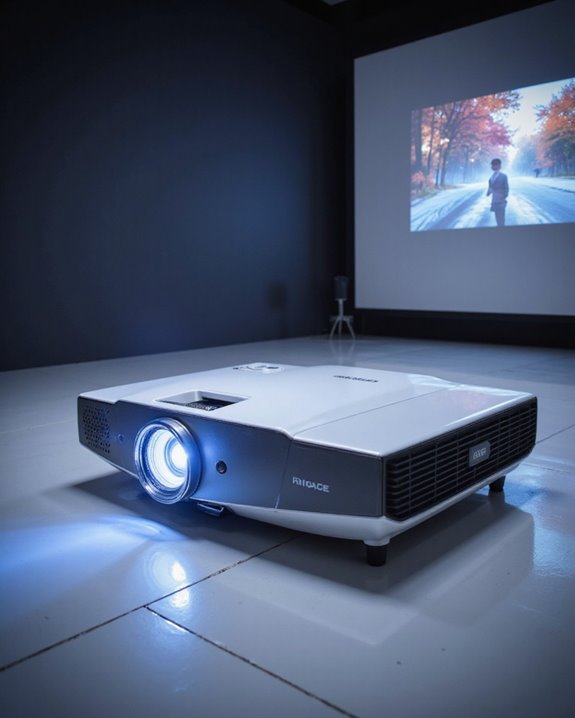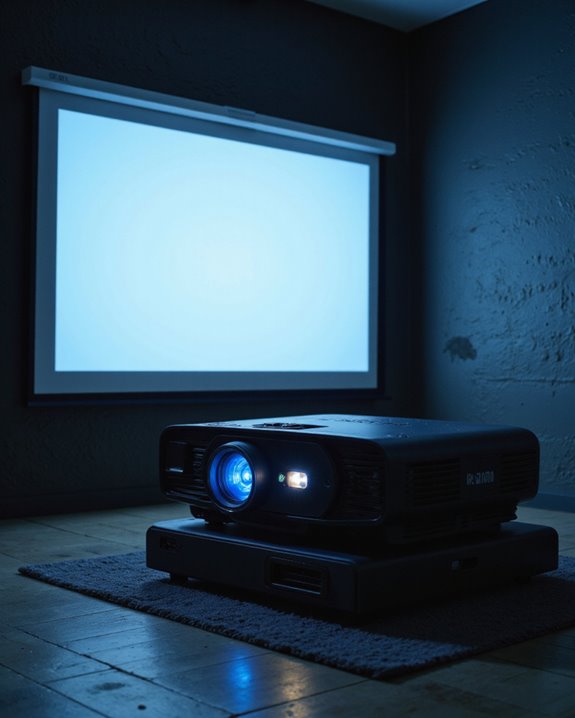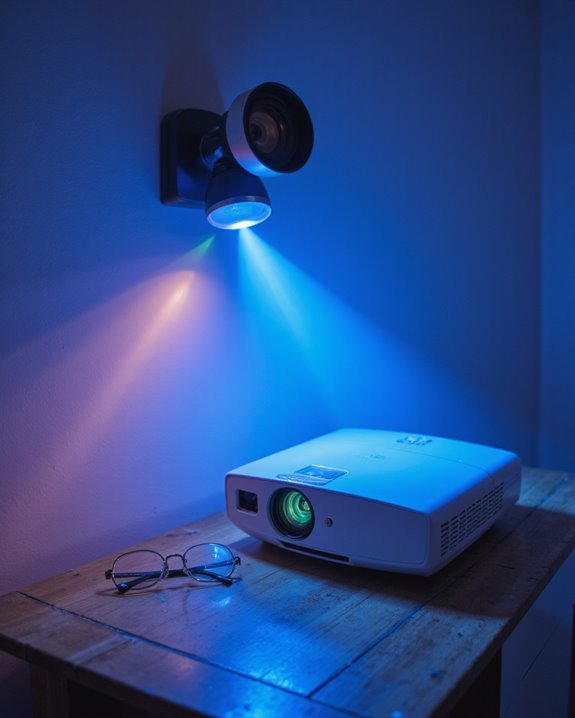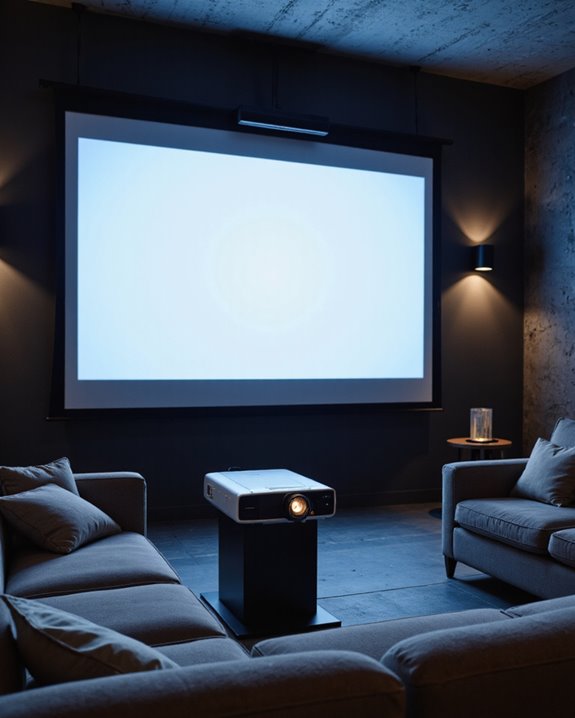A self-projected projector in television technology refers to a system, like a rear-projection TV, where an internal device projects images onto its own built-in screen. This differs from traditional projectors, which require an external surface. These systems use technologies such as LCD or DLP to create images, rely on lamp, LED, or laser light sources, and are designed for large screen sizes at lower cost. Next, key differences from modern flat-panel displays become clear.
Key Takeaways
- A self-projected projector refers to a television system where the projector and screen are integrated within a single device or cabinet.
- These systems, commonly called rear projection TVs, project images internally onto the back of the display screen.
- Unlike external projectors, no separate projection setup is needed—viewers watch directly on the built-in screen.
- Self-projected projectors often use technologies like DLP or LCD with internal light sources such as lamps, LEDs, or lasers.
- They offer larger screen sizes at lower costs compared to flat-panel TVs but have largely been replaced by modern display technologies.
Understanding Projection Systems in Television Technology
How do projection systems work within television technology, and why have they played such a significant role in image display? Projection systems in televisions use devices such as DLP (Digital Light Processing) or LCD (Liquid Crystal Display) to create images, which are then projected onto a screen using a built-in light source. This approach enables larger screen sizes at a lower cost compared to flat-panel TVs. Rear projection TVs house the projector inside the television cabinet, reflecting images onto the back of a screen. Image calibration, the process of adjusting brightness, color, and sharpness, is essential for achieving *ideal* image quality. However, ambient lighting—light present in the viewing area—can impact contrast and clarity, requiring dimmer environments for *excellent* performance. These systems offer flexibility, portability, and diverse applications. Additionally, the support for lightweight projectors in some stands has contributed to the growing popularity of portable projection setups.
Common Lamp and Light Source Technologies Used in Projectors
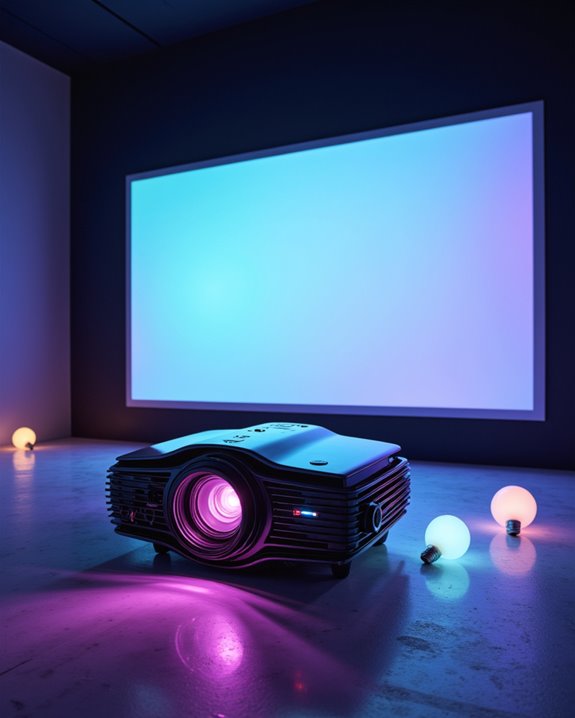
Projectors in television technology depend on different types of light sources to produce bright, clear images on screen. The main options include lamp-based, laser, and LED projectors. Lamp-based projectors use metal halide or ultra-high pressure (UHP) lamps, which provide strong brightness but require regular lamp replacement—typically every 2,000 to 10,000 hours. These lamps may also contain mercury, leading to disposal concerns. Laser projectors use semiconductor lasers, offering up to 20,000 hours of lifespan, consistent brightness, and lower maintenance. LED projectors, valued for LED efficiency, generate less heat, achieve similar lifespans to lasers, and reduce energy consumption. Hybrid models combine LED and laser benefits. Picture quality is usually comparable across types, but brightness and maintenance costs can vary markedly by technology. Advanced laser and LED projectors often feature longer-lasting light sources, reducing the need for frequent replacements and maintenance.
Comparing Projection TVS With Modern Display Alternatives
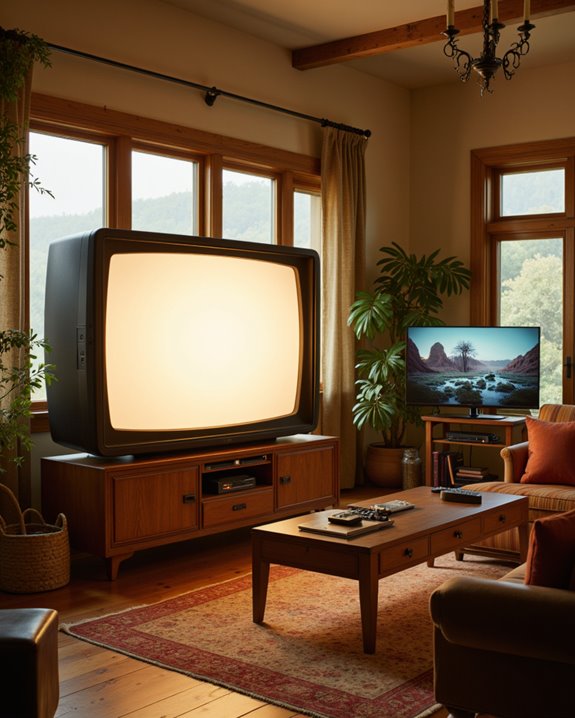
In recent years, the shift from projection televisions to modern display alternatives has dramatically changed how large-screen viewing is experienced in homes. Modern TVs, such as LED and OLED models, deliver higher native resolutions like 4K and 8K, resulting in sharper images and better color accuracy—meaning the colors look more realistic and true to life. Projection TVs, by contrast, often struggle with lower pixel density and are more affected by ambient light, which can wash out colors and reduce detail. Additionally, modern display technologies benefit from advanced image processing, which enhances picture clarity and motion handling for a more immersive experience.
Recent Innovations in Projection Technology

Why has projection technology advanced so quickly in recent years? Major improvements in image quality, brightness, and resolution are key drivers. Modern projectors deliver sharper images and richer colors, with many models supporting 4K resolution for detailed visuals. Technologies like LED and laser projectors use advanced lighting to achieve higher brightness levels and energy efficiency. Newer fiber-optic systems offer durability and improved illumination. Compact, portable designs increase versatility, while affordability has expanded access for consumers.
Recent innovations also include:
- Interactive displays: Projectors now allow touch interaction, useful in classrooms and workplaces.
- Holographic visuals: Some advanced models create three-dimensional images, enhancing presentations and entertainment.
Other features such as wireless connectivity, integrated speakers, and eco-friendly materials further enhance user experience and environmental sustainability.
Trends Shaping the Future of Television Projection Systems
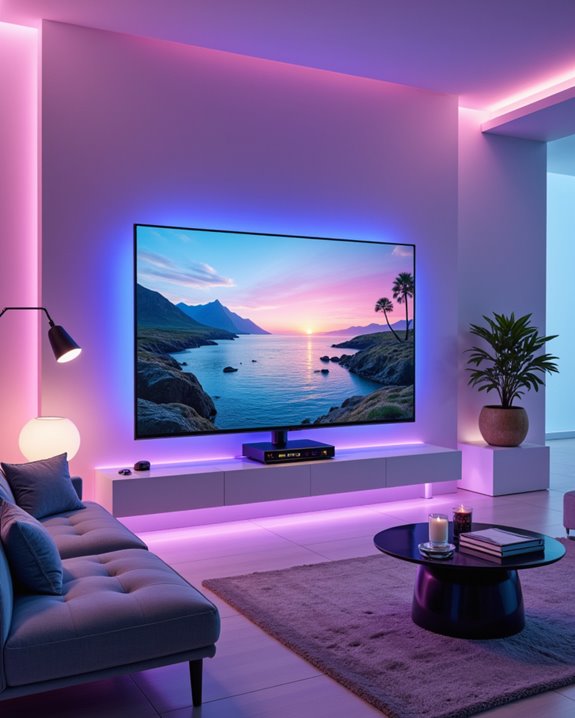
As television projection systems evolve, several key trends are shaping the direction of the technology. Larger screens—sometimes exceeding 100 inches—are delivering more immersive viewing experiences. High Dynamic Range (HDR), which improves contrast and color, continues to advance alongside Mini LED backlights for brighter, clearer images. AI integration is optimizing picture quality and automating adjustments based on the environment. Wireless connectivity is streamlining installations by reducing cable use.
Augmented Reality (AR) is emerging, blending digital visuals with real-world spaces for interactive displays. Projectors are now adopting smart features like voice control, operating systems, and compatibility with streaming services. Miniaturization is making devices more portable. Key advantages for projectors include cost-effectiveness, versatility, and ease of integration with smart home systems, supporting future innovation in interactive and adaptive display technologies.
Frequently Asked Questions
Is “Self-Projected Projector” a Term Used in Human Design or Television Technology?
The term “self-projected projector” appears in Human Design, not television technology. In projection terminology, its usage is specific to personal guidance, and would cause confusion or branding implications if applied within television or display industries.
Can a Projector’s Personality Type Influence Its Performance or Features?
The current question explores whether personality influence affects a projector’s performance or feature variations. In reality, projectors are technological devices, so their features and performance are determined by engineering and design, not personality types or traits.
What Is the Meaning of “Self-Projected Authority” Outside of TV Technology?
Self-projected authority, outside television technology, references a decision-making style where clarity emerges through vocalization. It embodies projection symbolism, as individuals express inner truths, and connects to authority in leadership by facilitating authentic guidance through self-expression.
Are There Any Psychological Concepts Linked to Projector Naming in Electronics?
The naming of projectors in electronics is unrelated to projection psychology or psychological projection. Instead, the term “projector” denotes devices projecting images, focusing on technical function rather than any psychological concepts or subconscious associations in naming.
Does “Self-Projected” Refer to a Projector’s Autonomy or Decision-Making Capabilities?
While “self-projected” evokes images of autonomy in devices or independent decision making processes, video projectors lack such features. Instead, their operation is externally controlled, with no inherent autonomy or self-driven decision-making capabilities present within the technology.

